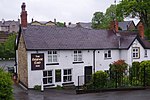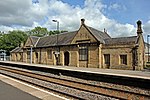Wat's Dyke

Wat's Dyke (Welsh: Clawdd Wat) is a 40-mile (64 km) linear earthwork running through the northern Welsh Marches from Basingwerk Abbey on the River Dee estuary, passing east of Oswestry and on to Maesbury in Shropshire, England. It runs generally parallel to Offa's Dyke, sometimes within a few yards but never more than three miles (5 km) away. It now appears insignificant, sometimes a raised hedgerow and in other places is now no more than a cropmark, the ditch long since filled in and the bank ploughed away, but originally it was a considerable construction, considered to be strategically more sophisticated than Offa's Dyke. The date of construction is disputed, ranging from sub-Roman to the early ninth century.
Excerpt from the Wikipedia article Wat's Dyke (License: CC BY-SA 3.0, Authors, Images).Wat's Dyke
Twining Hill,
Geographical coordinates (GPS) Address Nearby Places Show on map
Geographical coordinates (GPS)
| Latitude | Longitude |
|---|---|
| N 52.986666666667 ° | E -3.0286111111111 ° |
Address
Twining Hill
Twining Hill
LL14 6LL , Ruabon
Wales, United Kingdom
Open on Google Maps






